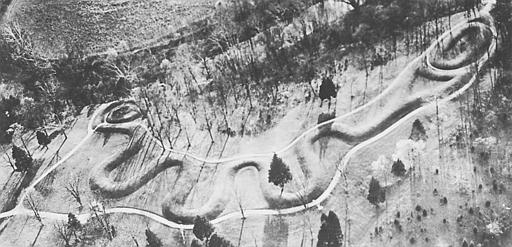Serpent Metal
Rock samples from beneath mound contain rare metal
CLEVELAND (AP) Scientists studying recent rock samples taken from beneath an ancient earthen mound are trying to determine what caused unusually high concentrations of a metal rarely seen anywhere but near Earth's molten core or in asteroids and comets.
Serpent Mound, an earthen snake effigy believed to have been built from about 1000 B.C. to A.D. 200 is about 60 miles east of Cincinnati. Some believe the 1,348-foot-long mound had a religious function for its builders, although nobody knows for sure what philosophy and beliefs shaped its origin because the mound builders left no written records.
Serpent Mound in Pleasant Hill, Ohio, is shown in this undated photo. Scientists studying recent  rock samples taken from beneath the ancient earthen mound are trying to determine what caused unusually high concentrations of a metal rarely seen anywhere but near Earth's molten core or in asteroids and comets. (AP Photo/The Cincinnati Enquirer) rock samples taken from beneath the ancient earthen mound are trying to determine what caused unusually high concentrations of a metal rarely seen anywhere but near Earth's molten core or in asteroids and comets. (AP Photo/The Cincinnati Enquirer)
Geologists only recently discovered high concentrations of iridium 1,412 feet beneath the mound. The levels of the silver-gray metal, occasionally brought up in lava from volcanoes, measured 10 times beyond what is usually present in the Earth's crust.
Since there are no lava fields in Ohio, some geologists point to the iridium as evidence that the mound sits upon a slightly oblong crater created when a massive extraterrestrial object slammed into Earth.
I think we can say with authority today that this is an impact from a meteorite, Mark T. Baranoski, a geologist with the Ohio Department of Natural Resources, told The Plain Dealer. It affected the region in a spectacular way.
Mike Hansen, a retired state geologist who runs an earthquake warning system and teaches at Ohio State University, said there is no doubt that the Serpent Mound area was disturbed by some unknown force. But Hansen thinks the stresses were triggered by natural shifts in the Earth's crust.
Fine grains of sand taken from beneath the mound appear deformed under a microscope. Around the time the rocks were deformed, Africa was pushing into North America and the Appalachian Mountains range was thrusting up higher than today's Himalayas, Hansen said. He said a major tectonic event like that could have created the underground chaos at Serpent Mound.
Hansen concedes, however, that the meteorite hypothesis is gaining adherents among geologists.
The object, if it did strike Ohio, would have been gigantic, possibly up to three times larger than the Cleveland Browns Stadium and traveling up to 45,000 mph. The heat, blast and shockwaves from such a crash would have carved a 1,000-foot-deep hole and crushed rocks miles below the five-mile across crater.
Researchers also have spotted microscopic cracks in quartz crystals far beneath the surface of the area and horsetail-shaped fractures called "shatter cones" in geological formations from the ground on down. The cracked crystals have patterns resembling those appearing after U.S. nuclear weapons tests in Nevada.
There are no other traces of a meteorite, but scientists say it would probably have vaporized when it hit 256 million years ago.
"I don't think we'll ever find it", Baranoski said. "It would have gone up in smoke. If anything was left near the surface, it would have been eroded away."
Doyle Watts, a geophysicist at Dayton's Wright State University who worked on the international team that studied the core samples, said the impact theory explains why so much of the terrain around Serpent Mound appears jumbled. Some rock formations rise 1,000 feet above the ground. Others look like they slid down.
Watts said he believes that the Indians who built Serpent Mound were prompted to construct what may have been a sacred monument for them after they saw the strange features in the land.
"It has to be more than coincidence", he said.
|


 rock samples taken from beneath the ancient earthen mound are trying to determine what caused unusually high concentrations of a metal rarely seen anywhere but near Earth's molten core or in asteroids and comets. (AP Photo/The Cincinnati Enquirer)
rock samples taken from beneath the ancient earthen mound are trying to determine what caused unusually high concentrations of a metal rarely seen anywhere but near Earth's molten core or in asteroids and comets. (AP Photo/The Cincinnati Enquirer)